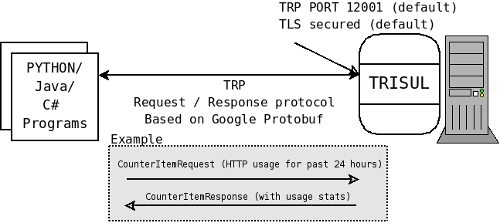The programming model
The main motivation of Trisul Remote Protocol is to allow remote automation of forensics tasks. From a single workstation you can connect to any number of Trisul probes and run your custom analysis and forensics tools.
TRP is a message based request-response protocol. The protocol is built using Google Protocol Buffers which provides a language neutral, backward compatible, and compact format. You can write scripts in any language such as Ruby, Python, or Java by using the protocol definition file trp.proto and binding them to a language of your choice.
div(success). All TRP messages are described in the TRP Messages and Fields page.
Request response
The Trisul Remote Protocol (known as TRP) provides an interface for clients to access the data collected by Trisul.

Key Features
* TRP is based on Protocol Buffers a
data interchange format introduced by Google.
* The entire protocol is specified in a single file called
trp.proto
* Allows clients to be written in Ruby/Python/Java/C#/C and any
language supported by Google Protocol Buffers
* Secure TLS with client authentication and Access Control Lists
* Access to traffic stats, flow details, flow investigation features
Synchronous operation
A client sends a request message to Trisul and waits for a response to that message. The protocol is synchronous. This means that you cannot have multiple outstanding requests on a single connection. You may however open any number of connections to Trisul.
The typical steps a developer needs to do :
# Construct a TRP message you want to send by filling in the
appropriate fields
# Serialize the message to a string
# Send across a 4 byte message length in **network byte** order
# Send across the serialized message itself
# Read a 4 byte response message length in **network byte** order
# Parse the response message
# Process the response as you see fit